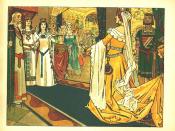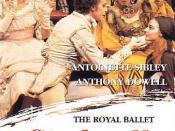Clothing plays a role in every person's life; often people are judged and defined by the types of things they wear. In "Cinderella: Not So Morally Superior," Elisabeth Panttaja claims that Cinderella succeeded in marrying the prince not because she was more patient than her stepsisters and stepmother, but because she was wittier and utilized the magical powers offered to her, namely an enchanted dress. In "A Feminist's View of 'Cinderella'," Madonna Kolbenschlag says that Cinderella tolerates condescension from the people around her in hope that she will one day be rewarded. She does menial labor and dresses in rags all while being told she is worthless by her stepmother. Ever After is a movie based on the same premise as many versions of the "Cinderella" tale. In the film, a girl named Danielle lives a similar life to Cinderella. Although Danielle and Cinderella both use fashion as a means to obtain something they want, Cinderella's fate is decided solely by her fashion whereas Danielle's use of fashion is not what ultimately draws the prince to her.
Still, Danielle seems to use clothing at first to slip into a role and define who she is; this is specifically evident in the scene where Danielle poses as a courtier.
In the movie "Ever After", Danielle is swept into a life of servitude by the hand of her stepmother after the sudden death of her father. One day, Danielle dons a fancy dress and poses as a courtier with the purpose of buying back a servant named Maurice that her stepmother, the Baroness, sold. While freeing Maurice, Prince Henry arrives and becomes intrigued by Danielle's wittiness and the mystery that shrouds her. Danielle quotes one of her favorite books, Utopia, and the prince insists on knowing her name. She becomes...


